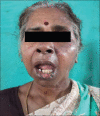Extracorporeal Plating of High-Level Condyle fracture Through Retromandibular Approach - A Technical Note
- PMID: 35018065
- PMCID: PMC8686923
- DOI: 10.4103/jpbs.jpbs_86_21
Extracorporeal Plating of High-Level Condyle fracture Through Retromandibular Approach - A Technical Note
Abstract
The complex anatomy of the mandibular condyle makes its fracture management challenging and debatable. Apart from this, the approaches to condyle are also challenging as most of them depend on the surgical expertise. The retromandibular approach which was initially proposed for the vertical sub condylar osteotomies was later popularized for condyle fracture management. It is considered to be a gold standard approach in the management of low condylar fractures. Although it has its own demerits in managing high condylar fracture due to its poor access and visibility, the major complications of temporary facial nerve paresis and sialocele are very less compared to other approaches. However, modified extracorporeal plating combined with retromandibular approach proves to be effective in managing high condylar fracture. In this article, we discuss about a case of bilateral neck of condyle fracture that has been managed with the combined modified extracorporeal plating with retromandibular approach and has been followed with no complications for about 1 year.
Keywords: Condyle fractures; extracorporeal plating; retromandibular approach; temporary facial nerve paresis.
Copyright: © 2021 Journal of Pharmacy and Bioallied Sciences.
Conflict of interest statement
There are no conflicts of interest.
Figures







References
-
- Baker AW, McMahon J, Moos KF. Current consensus on the management of fractures of the mandibular condyle. A method by questionnaire. Int J Oral Maxillofac Surg. 1998;27:258–66. - PubMed
-
- Chossegros C, Cheynet F, Blanc JL, Bourezak Z. Short retromandibular approach of subcondylar fractures: Clinical and radiologic long-term evaluation. Oral Surg Oral Med Oral Pathol Oral Radiol Endod. 1996;82:248–52. - PubMed
-
- Dingman RO, Grabb WC. Surgical anatomy of the mandibular ramus of the facial nerve based on the dissection of 100 facial halves. Plast Reconstr Surg Transplant Bull. 1962;29:266–72. - PubMed
-
- Ellis E, 3rd, McFadden D, Simon P, Throckmorton G. Surgical complications with open treatment of mandibular condylar process fractures. J Oral Maxillofac Surg. 2000;58:950–8. - PubMed
-
- Hinds EC, Girotti WJ. Vertical subcondylar osteotomy: A reappraisal. Oral Surg Oral Med Oral Pathol. 1967;24:164–70. - PubMed
Publication types
LinkOut - more resources
Full Text Sources
